|
There
was only one Buck Rogers serial,
but Flash Gordon flew into space three times
to battle the Satanically majestic Emperor Ming.
Question Number One has to be:
Why did Emperor Ming keep coming back
from the dead?
Ming was the prime villlain of Flash Gordon's
newspaper strip. Creators Alex Raymond, and
Don Moore used him as a common foe to rally
support for Flash, Dale, and Zarkov when they
traveled to all the different nations of Mongo.
Although there were many minor nuisances, and
a few worthy adversaries like Witch Queen Azura,
the Sax Roemer-like Emperor Ming was tailor-made
from pulp novels and newspapers of the 30's
-- the age of Mussolini, Stalin, Hitler, and
Franco. If repeated defeats weren't fatal for
Ming in William Randoph Hearst's Journal-American,
he wouldn't disappear from the silver screen
either!
Reason One: Ming was nearly as important
as Flash Gordon.
Charles Middleton brought such prescence and
dynamism to his portrayal of Ming that he dominated
the entire trilogy eventually. It might have
been true that he was tentative at first, but
he was confidently wicked and resourceful by
the second adventure, and swaggeringly domineering
all through the third. In retrospect it is obvious
that Middleton was the best actor in the entire
series, and splendidly focused the attention
of fellow cast members, listless writers, and
excited audiences -- all of whom thrived on
seeing their heroes prevail against such a charismatic
antagonist.
Reason Two: Ming was somehow impervious
to fire.
Flash Gordon's Trip to Mars repeatedly
demonstrates this special power of Ming, as
if answering Flash's remark: "We saw him
perish in those flames!" -- Referring to
Ming's apparent immolation in the Temple of
the Great God Tayo, near the end of the first
adventure.
Reason Three: Ming faked dying, with the
help of his henchmen.
Inexplicably, Ming had allies who shouldered
some of his dirty work. It made some kind of
convoluted sense that if Flash could escape
from the disintegration ray on Mars, then so
could the cunning Emperor.
Zarkov immediately suspected Ming for the Purple
Death dust, after spotting a Rocket Ship above
the Earth in the third adventure -- even though
Flash protested about seeing him dead. After
they flew back to Mongo, Dale, Flash, and Zarkov
learned their old nemesis was ruling the planet
again, with only a rueful nodding of Prince
Barin's head, instead of an explanation.
Question Number Two can be anything, but
I choose:
Why did Flash's second serial take place
on Mars anyway?
The Science Fiction genre had a long fascination
with our next-door neighbor since the days of
Percival Lowell's canals, and H.G. Wells' first
invasion-from-space novels. Interplanetary Space
was like Rafael Sabatini's Spanish Main, or
Zane Gray's Wild West in the so-called Space
Operas. Planet Mars was an important location
in the mythos -- much like Port Royal or Dodge
City in other genres.
Answer One: Flash Gordon competed
with other Space Operas.
If Flash stuck around in one place, he might
have lost some fans. For instance, rival Buck
Rogers rode around the Solar System like
Fran Striker's Lone Ranger in the newspapers.
Flash Gordon never left Mongo in the
newsprint adventures until after WWII began.
Azura was Witch Queen there before Beatrice
Roberts portrayed her as a magical Martian tyrant.
Some Universal episodes didn't mention Mars
at all, and there are a number of bloopers in
the dialogue which may indicate an executive
decision to send Flash to the Red Planet might
have been made after production started.
Rumor:
Universal tried to cash in on Orson Welles'
War of the Worlds.
Mercury Theater's Halloween broadcast, and the
hysteria caused by some fake news flashes during
the radio drama, caused a major media frenzy
in it's wake. Baby Boomer fans long assumed
this notorious event was the cause of Flash
temporarily relocating to yet another planet,
but there is decisive evidence to the contrary.
|
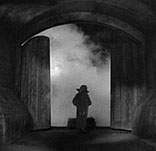
Temple
of the Great God Tayo
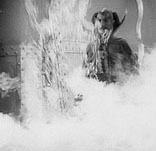
Fire-walking
on Mars
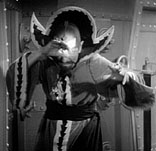
The Martian Disintegrator Ray
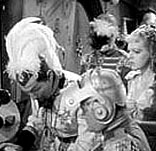
Is
Gordon crashing
into us?
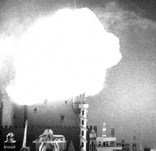
YES
-- after bailing out! |
| Emperor
Ming's Spitfire Relations, Enemies, Allies, and
Courtesans |
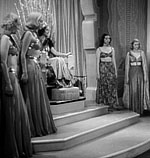
Witch
Queen Azura's Court |
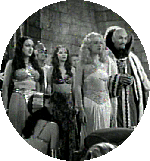
Aura,
Attendants, & Dale
|
|
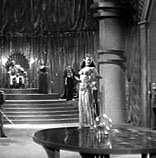
The
Glass Ball Dancer |
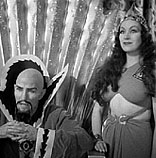
Imperial Family Business |
|
Squelching
the Rumor: Flash Gordon's Trip to Mars
was advertised 6 months before Orson Welles' Halloween
Broadcast.
Look
Magazine ran a series of articles outlining the
highlights of Flash Gordon's Trip To Mars
starting March 15, 1938 and ending April 12, 1938
Tony LaBue's wonderful Flash
Gordon Site has all three articles!
(Plus
great information about Charles Middleton, Jean
Rogers, Anne Gwynne etc.)
One
More Question for now: Why was Dale
Arden both Blonde and Brunette?
Blonde Dale Arden only appeared in the first Flash
Gordon serial.
Since her hair color was a major departure from
Alex Raymond's design in the newspapers, it is
fair to assume that, in this instance, someone
at Universal made the decision, possibly imitating
Jean Harlow's popular Blonde Bombshell.
The look of Dale Arden's' figure owed something
to Harlow's significant influence as well. Actress
Jean Rogers was always beautiful -- no matter
which color the makeup department might have dyed
her hair, or what silly costume she might have
worn off the studio's rack.
In Flash Gordon's Trip to Mars, Rogers
was not only Brunette, like Raymond's vision of
Dale Arden, but she was mostly covered up, and
buttoned up, throughout the adventure. Censorship
by the Hayes Office was a strong force in 1938.
Hearst/King Features toned down Flash Gordon
as the years progressed too.
One
detail was pretty funny -- Universal began Trip
to Mars with Flash, Dale, and Zarkov supposedly
returning from their initial foray into Outer
Space. The cast was exactly the same, BUT -- while
comparing the final shots of the first serial
(Left) with first shots of the second (Right),
there were significant differences: Dale Arden's
hair was dark, as if it had always been so; Their
Rocket Ship was not the same craft in which they
left Mongo; Their outfits were much more sedate;
and I bet the producers hoped their adolescent
audiences forgot the fade-out from two years earlier.
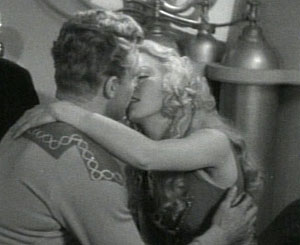 |
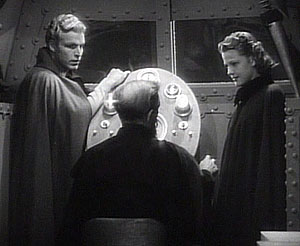 |
In
another ironic similarity, the producers reprised
the idea of a parachuting scene early on in the
plot. Blonde Dale first met Flash Gordon by sharing
a parachute with him while an inconvenient storm
destroyed their airplane. Brunette Dale waited
for Flash on solid ground in the second adventure.
The wind blew hard against Jean Rogers' clothes
in both sequences -- teasing the censors, but
staying within the bounds of decency.
|
| Flash
Gordon
and Buck Rogers are property of their copyright
holders. All images are used for scholastic
purposes ONLY in the context of these articles.
Text and graphic design copyright by Michael R.
Evans 2007
Email
Me
|
|